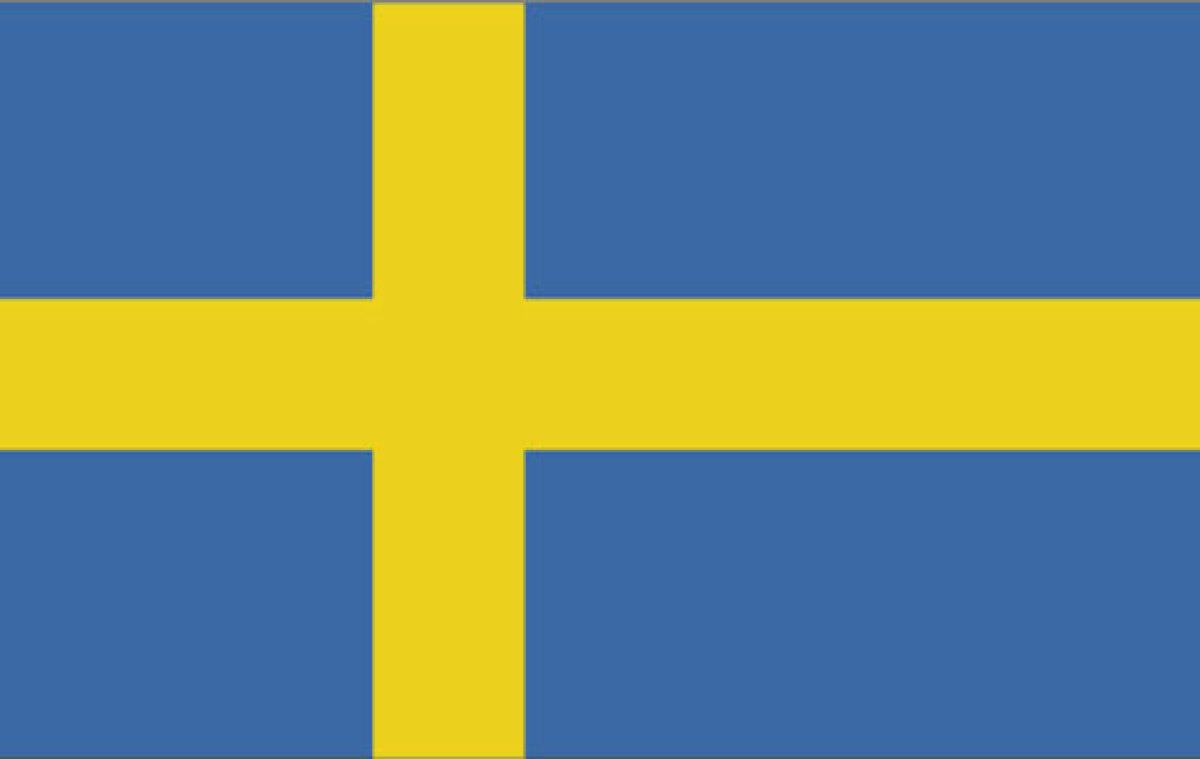Sweden Flag

Flag Date of Adoption
22 June 1906
Flag Symbolism
The exact age of the Swedish Flag is not known, but the oldest recorded pictures of a blue cloth with a yellow cross date from the 16th century. As decreed in a royal warrant of 1569, the yellow cross was always to be borne on Swedish battle standards and banners, as the Swedish Coat of Arms was blue divided quarterly by a cross of gold. The design of the Swedish flag is probably taken from the Danish flag, and its blue and yellow colours possibly come from the Coat of Arms. Not until the 1620s-i.e., during the reign of Gustav II Adolf-do we find any reliable evidence of the blue flag with a yellow cross being carried by Swedish vessels. According to our oldest existing flag warrant, from 1663, a triple-tailed flag was to be used except by merchant ships, whose flag was square-cut. Nowadays the use of the triple-tailed pennon is reserved for the Royal Family and the armed forces. The Royal Family may also charge its flags either with the Lesser or the Greater Coat of Arms in the centre of the cross.Since 1916, 6 June has been celebrated as the Swedish Flag Day. This finally also became Sweden's National Day in 1983. The reasons for the choice of date are twofold: the election of Gustav Vasa as Sweden's king on 6 June 1523 laid the foundation of Sweden as a separate state; and on the same date in 1809, Sweden adopted a new constitution which included the establishment of civil rights and liberties.
Sweden National Anthem
| Listen to National Anthem | |
| Anthem Lyrics |
"Du gamla, du fria"1) Du gamla, du fria, du fjällhöga Nord, du tysta, du glädjerika sköna! Jag hälsar dig, vänaste land uppå jord, din sol, din himmel, dina ängder gröna. Din sol, din himmel, dina ängder gröna. 2) Du tronar på minnen från fornstora dar, då ärat dit namn flög över jorden. Jag vet, att du är och du blir vad du var. Ja, jag vill leva, jag vill dö i Norden. Ja, jag vill leva, jag vill dö i Norden. |
| Anthem Lyrics English |
Thou ancient, thou freeborn, thou mountainous North, In beauty and peace our hearts beguiling, I greet thee, thou loveliest land on the earth, Thy sun, thy skies, thy verdant meadows smiling. Thy sun, thy skies, thy verdant meadows smiling. Thy throne rests on mem’ries from great days of yore, |
World Regions
All Countries
Afghanistan
Akrotiri
Albania
Algeria
American Samoa
Andorra
Angola
Anguilla
Antarctica
Antigua and Barbuda
Argentina
Armenia
Aruba
Australia
Austria
Azerbaijan
Bahamas
Bahrain
Bangladesh
Barbados
Belarus
Belgium
Belize
Benin
Bermuda
Bhutan
Bolivia
Bosnia and Herzegovina
Botswana
Brazil
British Indian Ocean Territory
British Virgin Islands
Brunei
Bulgaria
Burkina Faso
Burma
Burundi
Cabo Verde
Cambodia
Cameroon
Canada
Cayman Islands
Central African Republic
Chad
Chile
China
Christmas Island
Clipperton Island
Cocos (Keeling) Islands
Colombia
Comoros
Congo, Democratic Republic of the
Congo, Republic of the
Cook Islands
Coral Sea Islands
Costa Rica
Cote d’Ivoire
Croatia
Cuba
Curacao
Cyprus
Czech Republic
Denmark
Dhekelia
Djibouti
Dominica
Dominican Republic
Ecuador
Egypt
El Salvador
Equatorial Guinea
Eritrea
Estonia
Eswatini
Ethiopia
Falkland Islands
Faroe Islands
Fiji
Finland
France
French Guiana
French Polynesia
Gabon
Gambia, The
Gaza Strip
Georgia
Germany
Ghana
Gibraltar
Greece
Greenland
Grenada
Guadeloupe
Guam
Guatemala
Guernsey
Guinea
Guinea-Bissau
Guyana
Haiti
Holy See
Honduras
Hong Kong
Hungary
Iceland
India
Indonesia
Iran
Iraq
Ireland
Isle of Man
Israel
Italy
Jamaica
Jan Mayen
Japan
Jersey
Jordan
Kazakhstan
Kenya
Kiribati
Korea, North
Korea, South
Kosovo
Kuwait
Kyrgyzstan
Laos
Latvia
Lebanon
Lesotho
Liberia
Libya
Liechtenstein
Lithuania
Luxembourg
Macau
Madagascar
Malawi
Malaysia
Maldives
Mali
Malta
Marshall Islands
Martinique
Mauritania
Mauritius
Mayotte
Mexico
Micronesia
Moldova
Monaco
Mongolia
Montenegro
Montserrat
Morocco
Mozambique
Namibia
Nauru
Nepal
Netherlands
New Caledonia
New Zealand
Nicaragua
Niger
Nigeria
Niue
Norfolk Island
North Macedonia
Northern Mariana Islands
Norway
Oman
Pakistan
Palau
Panama
Papua New Guinea
Paraguay
Peru
Philippines
Pitcairn Islands
Poland
Portugal
Puerto Rico
Qatar
Reunion
Romania
Russia
Rwanda
Saint Helena, Ascension, and Tristan da Cunha
Saint Kitts and Nevis
Saint Lucia
Saint Pierre and Miquelon
Saint Vincent and the Grenadines
Samoa
San Marino
Sao Tome and Principe
Saudi Arabia
Senegal
Serbia
Seychelles
Sierra Leone
Singapore
Slovakia
Slovenia
Solomon Islands
Somalia
South Africa
Spain
Sri Lanka
Sudan
Sudan, South
Suriname
Svalbard
Sweden
Switzerland
Syria
Taiwan
Tajikistan
Tanzania
Thailand
Timor-Leste
Togo
Tokelau
Tonga
Trinidad and Tobago
Tunisia
Turkey
Turkmenistan
Turks and Caicos Islands
Tuvalu
Uganda
Ukraine
United Arab Emirates
United Kingdom
United States (US)
Uruguay
Uzbekistan
Vanuatu
Venezuela
Vietnam
Virgin Islands
Wake Island
Wallis and Futuna
West Bank
Western Sahara
World
Yemen
Zambia
Zimbabwe
